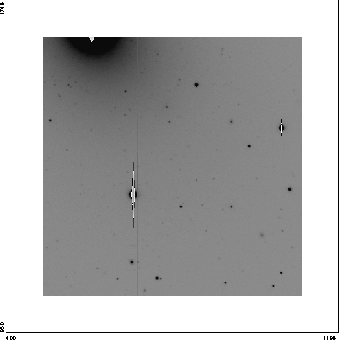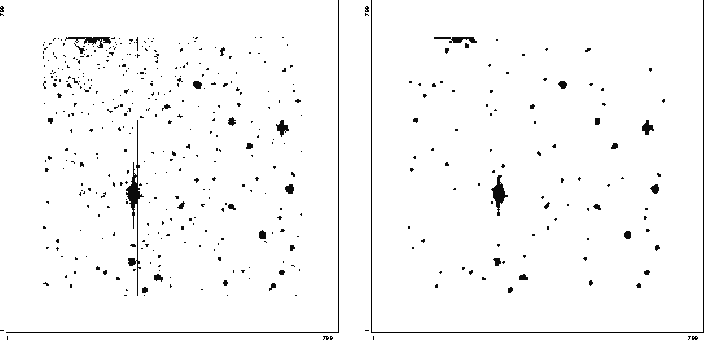




 1648 kB PostScript reprint
1648 kB PostScript reprint
Next: Unsupervised Catalog Classification
Up: Object Detection and
Previous: Classification of Objects
Astronomical Data Analysis Software and Systems IV
ASP Conference Series, Vol. 77, 1995
Book Editors: R. A. Shaw, H. E. Payne, and J. J. E. Hayes
Electronic Editor: H. E. Payne
F. Murtagh
ST-ECF, ESO, Karl-Schwarzschild-Str. 2, D-85748 Garching
Affiliated with the Astrophysics Division, Space Sciences
Department, ESA
W. Zeilinger
Department of Astronomy, University of Vienna, Türkenschanzstr. 17,
A-1180 Vienna
J.-L. Starck
CEA, DSM/DAPNIA, F-91191 Gif-sur-Yvette Cedex
A. Bijaoui
OCA, BP 229, F-06304 Nice Cedex 4
Abstract:
What we look for in an image is scale-dependent.
Multi-resolution allows for image analysis in terms of different
scales. Scale-space filtering, quadtrees, pyramid representations, and
the wavelet transform have all been used to yield multi-resolution views
of an image. One approach to the demarcation of significant structure,
at different resolutions, is to determine statistically significant parts of
each scale. A multi-resolution support data structure may be built up in this
way.
We can go further and incorporate a priori knowledge into the construction
of this multi-resolution support. Mathematical morphology offers a
convenient framework for removing detector artifacts, objects which are
too small in extent to be of interest, etc. This approach is used for
the detection (and subsequent analysis) of globular cluster systems around
elliptical galaxies, and for image characterization and object trawling in
large image databases.
Content-based image retrieval can be tackled by using text annotations which
characterize image content. Such
an approach has been prototyped
for Hubble Space Telescope ( HST)
WF/PC-1 data.
In this paper we describe the use of multi-resolution analysis for finding
and making an inventory of objects in an image. For the multi-resolution
transform, we used the pyramidal median image transform: see Starck, Murtagh,
& Louys (1995) for further details.
The use of Minkowski morphological operators allows prior knowledge relating
to the objects of interest to be introduced. The structuring element is
related to
the morphology of the objects of interest in the image. The choice adopted is
point-symmetric; and its size is related to potentially relevant objects.
Image dilations expand the object in a locally adaptive manner. The dilated
object area may help in providing extra faint or background pixels later when
the object is characterized using ellipticity, moments, or other properties.
Closings, or erosions with a suitable structuring element followed by dilations,
may be used to remove linear features that are not usually of interest in
astronomical imagery (e.g., extended cosmic ray impacts, bleeding and
charge-overflow effects in a CCD detector, and intersections of mosaiced
images).
Earlier work by Meurs et al. (1994) aimed at finding faint, edge-on galaxies
in WF/PC images. For each object found, properties such as the number of
pixels in the object, peak-to-minimum
intensity difference, a coefficient characterizing the azimuthal profile, and
the ellipticity of the principal axis, were used to allow discrimination between
potentially relevant objects on the one hand, and faint stars or detector
faults on the other.
This work is currently being extended with the study of globular cluster
systems. NGC 4636 was discussed by Kissler et al. (1993), and characterized
as a rich globular cluster system in a normal elliptical galaxy. An extracted
 sub-image from an ESO New Technology Telescope (NTT) image is
shown in Figure 1. A multi-resolution support of this image was obtained.
This multi-resolution support image with values 0, 2, 4, and 8 represents, in
one image, the four resolution levels examined.
Figure 2 shows the result of transforming the support image in Figure 1 to a
boolean image: any pixel with value greater than 2 was assigned a value of 1,
followed by two openings. The object ``islands'' are labeled, and an associated
report file produced principally with Gaussian profile fits in X and in Y.
This information can be used to
discriminate between objects of interest and those which are not.
sub-image from an ESO New Technology Telescope (NTT) image is
shown in Figure 1. A multi-resolution support of this image was obtained.
This multi-resolution support image with values 0, 2, 4, and 8 represents, in
one image, the four resolution levels examined.
Figure 2 shows the result of transforming the support image in Figure 1 to a
boolean image: any pixel with value greater than 2 was assigned a value of 1,
followed by two openings. The object ``islands'' are labeled, and an associated
report file produced principally with Gaussian profile fits in X and in Y.
This information can be used to
discriminate between objects of interest and those which are not.

Figure: Part of ESO NTT image of NGC 4636.
Original
PostScript figure (534 kB)

Figure: Booleanized multi-resolution support before and after 2 closings.
Original PostScript figures
(534 kB),
(534 kB)
.
The applicability of this approach to object detection in large image
collections has been investigated.
Rather than using original WF/PC data, the associated preview images
provide two advantages. Firstly they are available on-line. Secondly they
are smaller in size: typically about 1 MB per image when compressed,
compared to 10.5 MB in original form. On the negative side, the compression
scheme used in these preview images produces artifacts, and in particular the
image texture may be considerably affected. Mosaicing the WF/PC quadrants
also leaves the intersections bare.
A selection of WF/PC images was chosen with dense stellar fields,
sparse faint object fields, and filamentary structure. These images were
subjected to the following operations to allow for the great differences in the
image properties, due to varying exposure lengths, the different nature of
objects viewed, and presence of detector artifacts:
-
Multi-resolution
support construction.
- Level 4 in the multi-resolution support corresponds
to large gradient local peaks---if it and level 3 accounted for more than
20% of all pixels, then level 4 alone was retained; if
levels 4 and 3 together
accounted for less than 20% of the image's pixels, then they were combined
into a single boolean image. These
rules were employed to specify what could be considered as significant
objects in a given image.
- A set of up to 3 openings with point-symmetric
structuring elements were applied to remove remaining detector artifacts and
cosmic ray hits.
- Finally the contiguous regions were labeled and elementary
properties were determined (object extent, defined by numbers of pixels;
peak-to-minimum intensity within the object area, etc.).
This approach works well. Some remaining problems include the following:
closely located
objects are gathered into contiguous object ``islands'' in the final boolean
image; and the presence of faint filamentary structure in the image in not
explicitly handled when using structuring elements and a multi-resolution
transform kernel which presuppose small, point-symmetric objects.
In this work, we ask ourselves whether it is feasible to consider automated
image characterization through object detection and description.
Traditional object inventory packages include FOCAS and MIDAS/INVENTORY,
and are semi-interactive. Can a multi-resolution approach improve
generality of treatment, and accuracy of results?
Such established object inventory packages have
been limited to relative peaks in flux intensity and/or intensity gradient.
The multi-resolution transform incorporates these, and adds other potentially
valuable image properties. Included among these properties are: object resolution
scale (indirectly linked to gradient information); automatically ignoring the
image background (through differencing the images which make up the
multi-resolution transform); and facilitating incorporation of user-specified
image processing rules using, for example, Minkowski image operators.
References:
Kissler, M., Richtler, T., Held, E. V., Grebel, E. K., Wagner, S.,
& Cappaccioli, M. 1993, ESO Messenger, 32
Meurs, E. J. A., Murtagh, F., & Adorf, H.-M. 1994, IAU General Assembly
Starck, J.-L., Murtagh, F., & Bijaoui, A. 1995, 
Starck, J.-L., Murtagh, F., & Louys, M. 1995, 





 1648 kB PostScript reprint
1648 kB PostScript reprint
Next: Unsupervised Catalog Classification
Up: Object Detection and
Previous: Classification of Objects
adass4_editors@stsci.edu
 sub-image from an ESO New Technology Telescope (NTT) image is
shown in Figure 1. A multi-resolution support of this image was obtained.
This multi-resolution support image with values 0, 2, 4, and 8 represents, in
one image, the four resolution levels examined.
Figure 2 shows the result of transforming the support image in Figure 1 to a
boolean image: any pixel with value greater than 2 was assigned a value of 1,
followed by two openings. The object ``islands'' are labeled, and an associated
report file produced principally with Gaussian profile fits in X and in Y.
This information can be used to
discriminate between objects of interest and those which are not.
sub-image from an ESO New Technology Telescope (NTT) image is
shown in Figure 1. A multi-resolution support of this image was obtained.
This multi-resolution support image with values 0, 2, 4, and 8 represents, in
one image, the four resolution levels examined.
Figure 2 shows the result of transforming the support image in Figure 1 to a
boolean image: any pixel with value greater than 2 was assigned a value of 1,
followed by two openings. The object ``islands'' are labeled, and an associated
report file produced principally with Gaussian profile fits in X and in Y.
This information can be used to
discriminate between objects of interest and those which are not.

